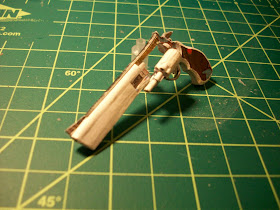- The distance from the trigger to the rear of the stock is 55+/- 1 mm.
- The trigger guard is around 10mm long from front to back.
- The handle width (in the plane of the barrel hole) is a nominal 5mm wide.
- The grip thickness (in the plane of a side profile) is around 7mm to be "wieldable" by a 1:6 scale figure. Larger sizes render the model un-wieldable, and smaller ones necessitate special features from the user's hand (spring loaded fingers) or extra tooling (rounding of the grip) of the handle.
- Rifle grip firearm distance from middle of trigger curvature to inner grip shall be 10mm.
- Pistol grip firearm distance from middle of trigger curvature to the back of pistol grip (where the web of the hand sits) shall be 12±0.5mm
 I had to re-scale the original draft done in August down by 85% in order to comply with the G-43 standard. The widths depicted on the upper right are still applicable.
I had to re-scale the original draft done in August down by 85% in order to comply with the G-43 standard. The widths depicted on the upper right are still applicable. Here's some diagrams of the finalized structure, and some idea of how it was assembled. Pretty sure if you're going to make your own, you'll buy a toy revolver, paint it silver and extend the front anyways. Otherwise, the dimensions aren't too relevant for you for this project.
Here's some diagrams of the finalized structure, and some idea of how it was assembled. Pretty sure if you're going to make your own, you'll buy a toy revolver, paint it silver and extend the front anyways. Otherwise, the dimensions aren't too relevant for you for this project. With the size comparison, the revolver is quite massive. It's about 6.5 cm long, making it a monstrous 39 cm long at 1:1 scale.
With the size comparison, the revolver is quite massive. It's about 6.5 cm long, making it a monstrous 39 cm long at 1:1 scale. This piece implements some small components that I was skeptical on successfully implementing. The cylinder swings out and spins. This is made possible by ample Loc-Tite to plastinate the paper and using paper clips to function as axles.
This piece implements some small components that I was skeptical on successfully implementing. The cylinder swings out and spins. This is made possible by ample Loc-Tite to plastinate the paper and using paper clips to function as axles. The cylinder is made of seven hollow tubes. Drilling holes into a semi-solid cylinder laminate was not an option. Making pivoting mechanisms using paper clips as an axle requires a bit of knowledge that is easily overlooked: paper clips are rarely round. The smaller ones usually have rectangular cross sections around a 16:19 aspect ratio. This results in a inner cylinder diameter that doesn't fit as tightly around the axle as a cylinder does, and if it does fit tightly, it doesn't spin easily. Also, paper clips are not always uniform in dimensions across multiple brands, so you may need to specially use one supplier source.
The cylinder is made of seven hollow tubes. Drilling holes into a semi-solid cylinder laminate was not an option. Making pivoting mechanisms using paper clips as an axle requires a bit of knowledge that is easily overlooked: paper clips are rarely round. The smaller ones usually have rectangular cross sections around a 16:19 aspect ratio. This results in a inner cylinder diameter that doesn't fit as tightly around the axle as a cylinder does, and if it does fit tightly, it doesn't spin easily. Also, paper clips are not always uniform in dimensions across multiple brands, so you may need to specially use one supplier source.I took advantage of the size difference to make cylinders using smaller rods, resulting in a tighter fit when using a slightly larger rod. The bottom of the cylinder arm uses this to prevent it from swinging out freely.
 Here's a detail of the individual components. The frame, held together with Loc-Tite, is a bit more sturdy than using regular Elmer's alone. The thin nature of the frame makes it vulnerable to deformation.
Here's a detail of the individual components. The frame, held together with Loc-Tite, is a bit more sturdy than using regular Elmer's alone. The thin nature of the frame makes it vulnerable to deformation.Here is the completed Ambassador revolver. Engraving was not a feasible option due to the fine width needed and lack of a solid substrate to implement it on. Printer paper doesn't quite work. The next best thing was to use a 0.30mm art pen and draw lightly. The small size allowed me to approximate the details since it would look quite dark and cluttered if every detail and line was inked in.


No comments:
Post a Comment